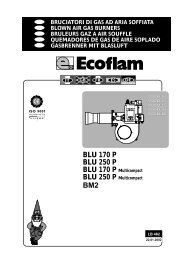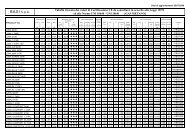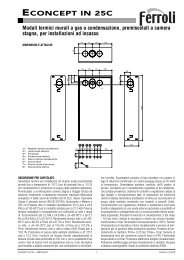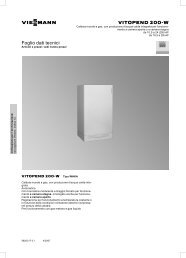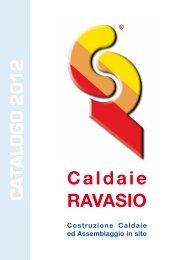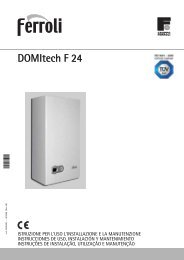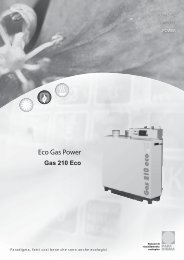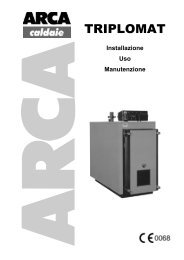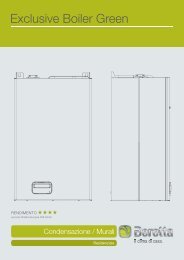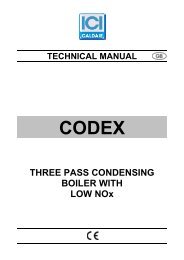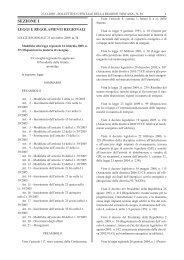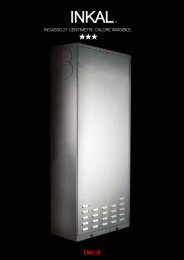aermec idrosplit - Certificazione energetica edifici
aermec idrosplit - Certificazione energetica edifici
aermec idrosplit - Certificazione energetica edifici
You also want an ePaper? Increase the reach of your titles
YUMPU automatically turns print PDFs into web optimized ePapers that Google loves.
zioni esterne e dalle condizioni termoigrometriche che si<br />
vogliono mantenere all’interno degli ambienti.<br />
Per avere una indicazione preventiva, è sufficiente sommare<br />
carichi termici di progetto degli ambienti in cui sono installati<br />
i ventilconvettori che si vogliono mantenere contemporaneamente<br />
in funzione; tale sommatoria dovrà essere inferiore<br />
o uguale alla resa del modulo ID. Quando i carichi<br />
termici sono meno gravosi, cosa che si verifica per la maggior<br />
parte della stagione, il numero di ventilconvettori attivi<br />
potrà essere maggiore.<br />
ESEMPIO DI SCELTA • SELECTION EXAMPLE<br />
Si propone un esempio di dimensionamento per un piccolo<br />
appartamento (circa 80 m 2 ) in un <strong>edifici</strong>o condominiale.<br />
L’impianto dovrà realizzare il riscaldamento invernale ed il<br />
condizionamento estivo; si utilizza il modulo Idrosplit associato<br />
ad una caldaia murale.<br />
L’impianto sarà quindi costituito da: un gruppo refrigeratore<br />
d’acqua (modulo ID + CX), una caldaia, una rete idraulica<br />
per la distribuzione dell’acqua calda o refrigerata, e da<br />
unità terminali per il trattamento dell’aria (per l’esempio si<br />
useranno i ventilconvettori della serie FCX).<br />
Il modulo ID e la caldaia saranno installati in posizione<br />
adiacente nella cucina soggiorno. L'unità motocondensante<br />
CX andrà installata all'esterno.<br />
La temperatura ambiente sarà regolata indipendentemente<br />
per ogni locale da un termostato che comanderà l’accensione<br />
o lo spegnimento del ventilatore dei ventilconvettori.<br />
L’appartamento è costituito da quattro locali, i cui carichi<br />
termici, in condizioni di progetto, sono ipotizzati nella<br />
seguente tabella 2:<br />
Tab. 2<br />
volume carichi term. carichi term.<br />
del locale estivi invernali<br />
(m 3 ) (W)* (W)**<br />
bagno 14 345 666<br />
camera bambini 34 840 1.085<br />
camera matrimoniale 38 1.300 1.260<br />
cucina-soggiorno 92 3.050 2.800<br />
* temperatura interna 27 °C b.s. e 19 °C b.u.<br />
** temperatura interna 20 °C<br />
DIMENSIONAMENTO INVERNALE<br />
Con criteri legati alla portata d’aria trattata e al comfort acustico<br />
si sono scelte le grandezze da installarsi nei vari locali.<br />
È stata scelta anche la velocità di funzionamento del gruppo<br />
ventilante in condizioni di progetto.<br />
Come si vede dalla tabella 3, la maggiore velocità viene<br />
riservata solamente ai periodi di messa a regime.<br />
Tab. 3<br />
grandezza quantità<br />
velocità di funz.<br />
di progetto<br />
bagno FCX 16 1 media<br />
camera bambini FCX 21 1 minima<br />
camera matrimoniale FCX 31 1 minima<br />
cucina-soggiorno FCX 31 2 media<br />
Si procede ora alla scelta delle portate d'acqua nei ventilconvettori<br />
e alla verifica delle potenze rese.<br />
Nelle tav. 13-14-15 si leggono le rese termiche relative alle<br />
grandezze prescelte con ∆t = 30 °C, ricavato ipotizzando<br />
una temperatura dell’acqua d’alimentazione pari a 50 °C e<br />
una temperatura dell’aria in ingresso pari a 20 °C.<br />
Si può allora ipotizzare per ogni ventilconvettore una portata<br />
d’acqua, indicata nella tabella 4, superiore, per sicurezza,<br />
a quella minima necessaria.<br />
Si vede che le rese dei ventilconvettori, con le portate di<br />
acqua proposte, sono più che sufficienti a soddisfare i cariclimatic<br />
conditions that must be maintained in the locations.<br />
To make a preliminary estimate, just sum the design thermal<br />
loads of the locations where the fancoils are installed,<br />
which need to be operated simultaneously. The result must<br />
be lower or equal to the capacity of the ID module. When<br />
the thermal loads are less significant, which is usually for<br />
most of the season, the number of fancoils active may be<br />
increased.<br />
As a sizing example, we will use for a small apartment<br />
(about 80 m 2 ) in an apartment block.<br />
The plant must provide winter heating and summer air-conditioning.<br />
The Idrosplit module is used in conjunction with<br />
a wall boiler.<br />
The plant will therefore include: a water chiller group (ID +<br />
CX), a boiler, hydraulic piping to distribute the hot or chilled<br />
water, and terminal units to handle the air (in this example<br />
we will use fancoils from the FCX series).<br />
The ID module and the boiler will be installed next to each<br />
other in the kitchen-living room. The CX condensing unit<br />
will be installed outside.<br />
The temperature will be controlled independently for each<br />
room by a thermostat which commands the fan start and<br />
stop of the fancoils.<br />
The apartment is made up of four rooms, whose thermal<br />
loads, in the design conditions, are given in table 2:<br />
Tab. 2<br />
volume summer winter<br />
of room thermal load thermal load<br />
(m 3 ) (W)* (W)**<br />
bathroom 14 345 666<br />
child’s bedroom 34 840 1.085<br />
parents bedroom 38 1.300 1.260<br />
kitchen-living room 92 3.050 2.800<br />
* indoor temperature 27°C d.b. and 19°C w.b.<br />
** indoor temperature 20°C<br />
WINTER SIZING<br />
With the factors tied to a comfortable air flow and noise<br />
levels, select the sizes to install in the various rooms.<br />
Even the operating speed of the fan group is selected at<br />
design conditions.<br />
As shown in table 3, the highest speed is left for the start-up<br />
period.<br />
Tab. 3<br />
size<br />
design operating<br />
quantity<br />
speed<br />
bathroom FCX 16 1 medium<br />
child’s bedroom FCX 21 1 minimum<br />
parent’s bedroom FCX 31 1 minimum<br />
kitchen-living room FCX 31 2 medium<br />
Now proceed with the selection of the water flow in the<br />
fancoils and the performances checks.<br />
Tab. 13-14-15 give the thermal capacities related to the<br />
sizes selected witth ∆t=30°C, obtained taking a supply<br />
water temperature of 50°C and an inlet air temperature of<br />
20°C. Let us then assume that each fancoil has a water flow,<br />
given in table 4, for safety sake, above the minimum requirement.<br />
The fancoil performances, with the proposed water<br />
flows, prove to be more than adequate to satisfy the design<br />
thermal loads.<br />
For example, for the parent’s bedroom 1.260 W are suffi-<br />
CARATTERISTICHE • FEATURES<br />
17



